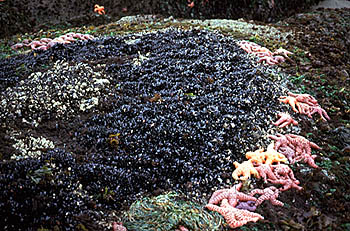 Visit
Source of Image
Visit
Source of Image
Click link to return to Lecture
Schedule
or Lecture Notes by Chapter
Back to Chapter 13
Forward to Chapter 15
Case History: M.A.D. (Mutual
Assured Destruction)
at Marcus
Island
Summary from The Scientist (1988):
The biota of Malgas Island off the west coast
of South Africa is dominated by seaweeds and by
rock lobsters that consume settling mussels,
preventing them from becoming established, they
also prey on whelks. Marcus Island, four km away,
has extensive mussel beds and whelks at
high densities, but rock lobsters and seaweeds
are virtually absent. Rock lobsters transferred to
Marcus Island are overwhelmed and consumed by
the whelks—a reversal of the normal
predator-prey relation between the two species.
A. Barkai, C. McQuaid, “Predator-prey role reversal
in a marime benthic ecosystem,”
Science, 242 (4875), 62-4,7 October 1988.
RQ 14.1: Why are whelks unable to
become established when
rock lobsters are dominant, nor rock lobsters when whelks
dominate? Explain why this could be an example of what
community ecologists refer to as "alternative persistent
steady states."
I. Deep versus Shallow Waters
RQ 14.2 (Fig. 14.1): Give two reasons
why shallow water
depths are more likely to be productive than deeper
water depths. Why doesn't wind tend to directly cause
upwelling of nutrients?
II. Life on Intertidal and Shallow Rocky Bottoms
a) Rocky Intertidal Communities
RQ 14.3: What are a few of the reasons
why the rocky
intertidal
has been so important for ecological studies, even though
it represents a relatively tiny portion of the Earth's marine
habitat?
1) Ecological
process 1: Disturbance increases species
diversity.
terms: keystone
species, stability-time hypothesis,
intermediate disturbance hypothesis (described but
not referred to by this name in text), zonation
patterns
Featured
organisms:
Pisaster
ochraceus (ochre seastar)
Featured marine ecologist (published classic
studies):
Robert
Paine
RQ 14.4: Why is Pisaster
ochraceus referred to as a keystone
predator?
RQ 14.5: Why does disturbance increase
species diversity?
What is the stability-time hypothesis?
Other members of the genus, Pisaster, have
similar ecolotical importance in the kelp forest
(P.
giganteus) and on sandy bottoms (P.
brevispinus).
2) Ecological
process 2: Many species live in
suboptimal habitats.
Featured
organisms:
Chthamalus
spp. (say "thamalus" or little brown acorn barnacle)
Balanus
spp. (larger white acorn
barnacle)
Nucella
lapillus (predatory whelk, a carnivorous snail)
Featured marine ecologist (published classic
studies):
Joseph Connell
Connell performed his studies in Scotland, but similar species of
Balanus, Chthamalus, and Nucella live
on the California coast.
Compare these species to similar "high
zone" species in Australia.
RQ 14.6 (Fig. 14.3): Note that the
barnacle, Chthamalus, settles from
the plankton from high to low on the shore but only survives to
adulthood in the high intertidal. Connell formulated three (and more)
alternative hypotheses to explain this failure to survive in the
lower intertidal: predation, drowning, and competition. Explain
how Connell's "experimental manipulation" experiments were
able to test between these alternative hypotheses.
3) Ecological
process 3: Systems can have more
than one persistent steady state.
RQ 14.7 (Fig. 14.4): Relate the
example of New England tidepools,
studied by Jane
Lubchenco, to the above "M.A.D." example.
How are these studies similar? Explain how "crab" and "snail"
pools each resist change through time. How was this experimentally
demonstrated?
b) Rocky Subtidal Communities
1) Kelp forests
are among the most productive communities
on Earth.
RQ 14.8: In what ways are kelp forest
communities considered to
be among the most productive marine communities?
2) Unconstrained
feeding by urchins appears to eliminate
kelp on shallow rocky bottoms (see Ch. 9 notes).
RQ 14.9: Keep the following study
guides in mind as you
read the remainder
of Chapter 14. Compare the following
habitats with
respect to:
1) physical
characteristics; 2) typical communities;
3) amount of
productivity; 4) source of productivity;
5) relative
degree of disturbance; 6) long-term fluctuations
Rocky intertidal
Kelp Forests
Cobble beaches
Sandy beaches
Muddy beaches
Salt marshes
Mangrove forests
Sea grass communities
Estuaries
Coral reefs
a) Cobbles, Sand, and Mud
RQ 14.10: Contrast sediment habitats: cobbles, sand, and mud.
b) The Interstitial Fauna
terms: interstitial fauna, meiofauna
RQ 14.11: What are some typical
characteristics of interstitial fauna?
Why does the interstitial fauna produce more biomass each year
than the macrofauna, even though the macrofauna typically
outweighs the interstitial fauna?
c) Predation on Sediment Bottoms
RQ 14.12: What did Robert Virnstein
conclude from his experiments
with predator-exclusion cages on sandy bottoms that was different
from Robert Paine’s study of the rocky intertidal?
d) Sandy Shores
RQ 14.13 (Figs. 14.11-12): Briefly
describe the "zonation" of organisms
from exposed shore to inland dunes for the Padre Island, Texas,
shoreline.
IV. Vascular Plant Communities
a) Salt Marshes
terms: energy subsidy
RQ 14.14: Why are West Coast salt
marshes poorly developed?
Why are they so productive, even if they are not diverse in
numbers of species?
b) Mangrove Forests
terms: mangals
RQ 14.15: Where are mangrove forests
found? How are trees
able to survive submerged in salt water?
c) Sea Grasses
1) Sea grasses
have active roots, symbiotic partners,
and high productivity.
2) Sea grasses
feed herbivores, detritus feeders, and
bacteria; and they moderate disturbance by predators.
3) Was the
great eelgrass epidemic of 1931 a preview
of an effect of global warming?
V. Estuaries
a) Biological Makeup, Productivity,
and Unique Features of
Estuaries
RQ 14.16: In what ways are estuaries important?
b) Important Nurseries and Vulnerable
Invasion Ports
terms: exotic species
VI. Coral Reefs
a) The Reef Builders and Their Giant
Living Monument
terms: algal ridges, patch reefs, hermatypic corals,
bioerosion
b) Plants and Food Webs
terms: cryptic
RQ 14.17: Why are coral reefs important?
What characterizes most
of the plants in coral reef habitats?
c) Herbivores, Competitors, Predators
- Major Agents of
Disturbance
RQ 14.18: What are major forms of
disturbance to coral reefs?
Click link to return to Lecture
Schedule
or Lecture Notes by Chapter
Back to Chapter 13
Forward to Chapter 15
This page created 4/18/01 © D.J. Eernisse, Last Modified 4/30/01